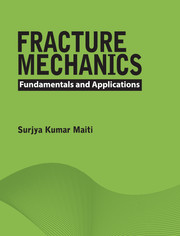Book contents
- Frontmatter
- Dedication
- Contents
- List of Figures
- List of Tables
- Preface
- 1 Introduction
- 2 Linear Elastic Fracture Mechanics
- 3 Determination of Crack-Tip Stress Field
- 4 Crack Opening Displacement, J Integral, and Resistance Curve
- 5 Determination of Stress Intensity Factors
- 6 Mixed Mode Brittle Fracture
- 7 Fatigue Crack Growth
- 8 Elastic Plastic Fracture Mechanics
- 9 Experimental Measurement of Fracture Tougness Data
- Index
- References
9 - Experimental Measurement of Fracture Tougness Data
Published online by Cambridge University Press: 05 February 2016
- Frontmatter
- Dedication
- Contents
- List of Figures
- List of Tables
- Preface
- 1 Introduction
- 2 Linear Elastic Fracture Mechanics
- 3 Determination of Crack-Tip Stress Field
- 4 Crack Opening Displacement, J Integral, and Resistance Curve
- 5 Determination of Stress Intensity Factors
- 6 Mixed Mode Brittle Fracture
- 7 Fatigue Crack Growth
- 8 Elastic Plastic Fracture Mechanics
- 9 Experimental Measurement of Fracture Tougness Data
- Index
- References
Summary
Introduction
This chapter deals with the experimental methods related to the measurement of fracture toughness and determination of resistance curves. All tests are done as per certain standards. The standards are generally very exhaustive; they provide all relevant information that may be needed about a test. Useful information in brief about the different testing is presented in this chapter.
Measurement of Plane Strain Fracture Toughness KIC
KIC testing is mostly done as per ASTM E399-90 (Reapproved 1997) (2000) or its equivalent.
The standard specifies specimen geometry, procedure for preparation of specimen, testing machine requirements, the sensitivity of measurement devices, and testing fixtures, and gives guidelines for conducting tests and data collection, along with methods of calculation of toughness and reporting of the experimental data. For a rolled or forged material, there are three distinct directions of symmetry: longitudinal (L), transverse (T), and short transverse (S). The toughness of such a material will depend on the orientation of the crack and the direction of loading during testing. If the loading is in the longitudinal direction and the crack plane is in the short transverse direction, the specimen is identified as L–S specimen; if the loading is in the transverse direction and the crack plane is in the short transverse direction, the specimen is identified as T–S specimen. Thus there are six possible combinations: L–S, S–L, L–T, T–L, S–T, and T–S. Three such combinations are illustrated in Fig. 9.1.
The two most commonly used specimen geometries, compact tension (CT) and three point bend (TPB), are shown in Figs. 9.2 and 9.3, respectively. Arc-shaped specimens are also recommended to facilitate their preparation from pressure vessel stock. For a measured fracture toughness KIC data to be valid according to this standard, specimen thickness B and crack size a must be greater than where σY is the yield point of the material. In the absence of a distinct yield point, 0.2% proof stress can be employed. This calls for an initial estimation of the toughness of the material.
- Type
- Chapter
- Information
- Fracture MechanicsFundamentals and Applications, pp. 257 - 272Publisher: Cambridge University PressPrint publication year: 2015



